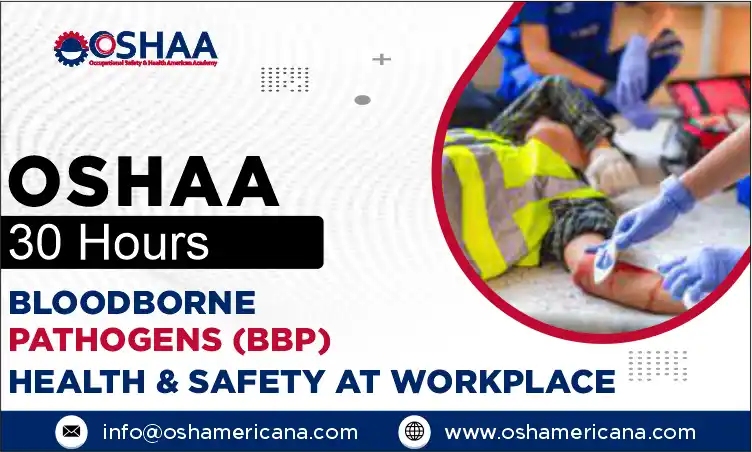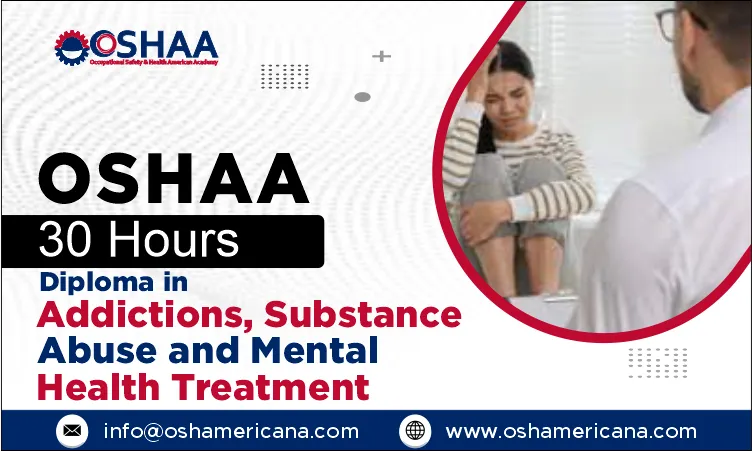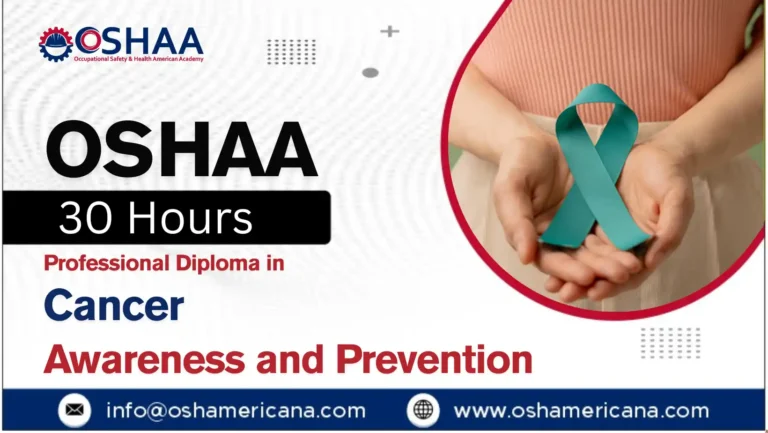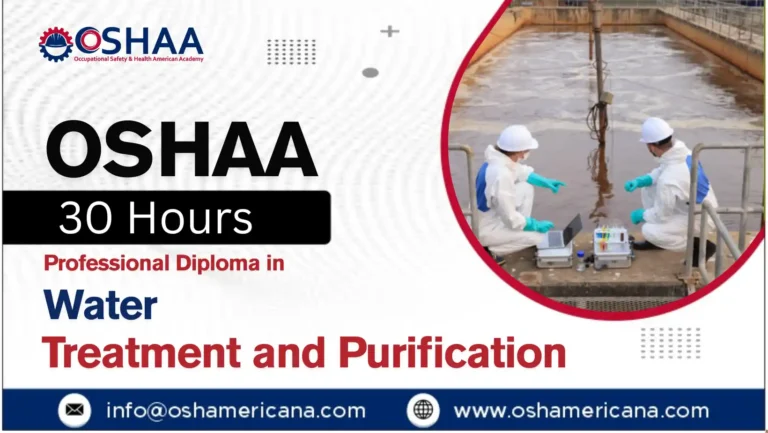Gain essential skills with the OSHAA 30-Hours Bloodborne Pathogens (BBP) – Health & Safety at Workplace course. Ensure compliance, safety, and professional growth.
The OSHAA 30-Hours Bloodborne Pathogens (BBP) – Health & Safety at Workplace course is a comprehensive training program designed to equip professionals with the knowledge, skills, and confidence to handle workplace health risks associated with bloodborne pathogens. In today’s demanding industries, from healthcare and emergency medical services to sanitation and cleaning operations, the risk of exposure to bloodborne pathogens remains one of the most critical safety concerns. This course addresses those risks directly, ensuring employees are fully prepared to respond appropriately, minimize hazards, and maintain a safe and compliant workplace environment.
Understanding and managing bloodborne pathogens is essential for anyone who may come into contact with blood or other potentially infectious materials (OPIM). Without the proper training, such exposures can lead to life-threatening consequences and severe workplace health risks. The OSHAA 30-Hours Bloodborne Pathogens (BBP) – Health & Safety at Workplace course provides participants with the tools to protect themselves, their colleagues, and the wider community. Through structured learning, participants gain insights into how pathogens are transmitted, the importance of protective equipment, proper hygiene practices, safe disposal methods, and effective response strategies in case of accidental exposure.
The significance of this training extends beyond individual safety. Employers who enroll their staff in the OSHAA 30-Hours Bloodborne Pathogens (BBP) – Health & Safety at Workplace course demonstrate their commitment to OSHA compliance, workplace health standards, and overall professional development. By reducing the chances of accidental exposure, organizations not only safeguard their workforce but also enhance operational efficiency, reduce liability, and foster a culture of safety across their teams.
This course is particularly relevant to healthcare workers, first responders, laboratory technicians, cleaning personnel, and other professionals working in environments where bloodborne pathogens present a potential hazard. By completing the OSHAA 30-Hours Bloodborne Pathogens (BBP) – Health & Safety at Workplace program, participants gain both practical knowledge and professional credibility, ensuring they can confidently contribute to creating and maintaining safer workplaces.
In essence, the OSHAA 30-Hours Bloodborne Pathogens (BBP) – Health & Safety at Workplace course is not just a training requirement; it is an investment in safety, compliance, and professional growth. With its emphasis on prevention, awareness, and preparedness, this program plays a crucial role in protecting lives, improving workplace health standards, and advancing career opportunities for those committed to excellence in health and safety practices.
OSHAA 30-Hours Bloodborne Pathogens (BBP) – Health & Safety at Workplace
To enroll in the OSHAA 30-Hours Bloodborne Pathogens (BBP) – Health & Safety at Workplace course, learners are expected to meet the following criteria:
Age Requirement
- Applicants must be at least 18 years of age to register for the OSHAA 30-Hours Bloodborne Pathogens (BBP) – Health & Safety at Workplace course. This ensures that participants possess the maturity and responsibility necessary to fully engage with the training content and apply safety standards effectively in professional environments.
Educational Background
- A minimum of a high school diploma or equivalent qualification is recommended for learners enrolling in the OSHAA 30-Hours Bloodborne Pathogens (BBP) – Health & Safety at Workplace course. While this course is designed to be accessible to a wide range of professionals, individuals with higher education or a background in healthcare, emergency services, laboratory sciences, or occupational health may find the training particularly advantageous for advancing their careers and applying course principles effectively.
Work Experience
- Prior work experience is not a strict requirement to participate in the OSHAA 30-Hours Bloodborne Pathogens (BBP) – Health & Safety at Workplace course. However, those already working in healthcare, sanitation, emergency response, or other roles with potential exposure to bloodborne pathogens will benefit greatly from the immediate application of the training. For newcomers to these fields, the course provides a strong foundation in safety standards, compliance, and professional best practices.
English Proficiency
- To successfully complete the OSHAA 30-Hours Bloodborne Pathogens (BBP) – Health & Safety at Workplace course, learners must have the ability to read, write, and communicate in English. Proficiency in English is essential for understanding the training materials, following safety protocols, and meeting OSHA compliance requirements. This ensures that participants can fully engage with the course and apply the knowledge to real-world workplace situations.
Study Units
Learning Outcomes
The Learning Outcomes of the OSHAA 30-Hours Bloodborne Pathogens (BBP) – Health & Safety at Workplace course are designed to equip learners with advanced knowledge, practical skills, and regulatory awareness necessary to manage occupational risks effectively. By focusing on compliance with OSHA standards and international best practices, this course enables participants to strengthen workplace safety measures, reduce exposure risks, and develop leadership in health and safety management.
- Introduction to Bloodborne Pathogens (3 Hours)
- Define bloodborne pathogens and explain their impact on workplace health and safety.
- Recognize common pathogens such as HIV, HBV, and HCV and understand their health implications.
- Explain the importance of training and awareness in minimizing occupational risks.
- Modes of Transmission (4 Hours)
- Identify how bloodborne pathogens are transmitted in workplace environments.
- Differentiate between direct, indirect, airborne, and contact transmission routes.
- Apply preventative strategies to break the chain of infection effectively.
- Understand the role of workplace hygiene in reducing risks of exposure.
- Occupational Risk Factors (4 Hours)
- Recognize high-risk occupations and job roles vulnerable to bloodborne pathogen exposure.
- Analyze workplace activities that increase the likelihood of contact with infectious materials.
- Apply risk reduction strategies to safeguard both employees and employers.
- Demonstrate an understanding of global standards for occupational health and safety.
- Bloodborne Pathogen Exposure Control Plan (4 Hours)
- Explain the components of an effective Exposure Control Plan.
- Design workplace strategies to minimize contact with infectious materials.
- Implement engineering and administrative controls to reduce exposure risks.
- Evaluate existing control plans for compliance and effectiveness.
- Personal Protective Equipment (PPE) and Safe Work Practices (4 Hours)
- Demonstrate proper selection, use, and disposal of PPE in workplace settings.
- Apply safe work practices to minimize occupational hazards.
- Understand the limitations of PPE and reinforce its use with additional safety measures.
- Promote consistent use of protective measures as part of organizational culture.
- Post-Exposure Protocols (4 Hours)
- Describe immediate response actions following exposure incidents.
- Understand medical evaluation and follow-up procedures in line with OSHA requirements.
- Implement workplace reporting systems for exposure events.
- Apply lessons learned from incidents to strengthen workplace safety programs.
- Legal and Regulatory Requirements (3 Hours)
- Interpret OSHA regulations and international compliance standards related to bloodborne pathogens.
- Identify employer and employee responsibilities under workplace safety laws.
- Demonstrate knowledge of documentation and record-keeping requirements.
- Ensure compliance with both local and global occupational health guidelines.
- Risk Assessment and Infection Control Strategies (4 Hours)
- Conduct workplace risk assessments to identify potential exposure hazards.
- Develop infection control strategies aligned with OSHA and global standards.
- Integrate preventive measures into daily workplace operations.
- Promote proactive approaches to monitoring and improving safety protocols.
By completing the OSHAA 30-Hours Bloodborne Pathogens (BBP) – Health & Safety at Workplace course, learners will gain the ability to identify, assess, and mitigate risks associated with bloodborne pathogens. Participants will not only enhance their technical expertise and compliance knowledge but also strengthen their leadership in workplace health and safety. This course prepares professionals to drive safety initiatives, ensure regulatory compliance, and foster a strong culture of protection and responsibility across diverse industries worldwide.
The OSHAA 30-Hours Bloodborne Pathogens (BBP) – Health & Safety at Workplace course offers extensive benefits for individuals, organizations, and stakeholders committed to creating safer professional environments. By focusing on both compliance and advanced safety practices, this training provides learners with the essential skills to prevent exposure, protect colleagues, and foster a culture of accountability. It holds global importance as it aligns with OSHA regulations and international health and safety standards, making it invaluable for professionals across multiple industries. Completing this course enhances workplace resilience, promotes professional development, and safeguards organizational credibility in an increasingly regulated and safety-conscious world.
- Enhanced Workplace Safety
Gain the knowledge and skills necessary to prevent, identify, and respond to potential bloodborne pathogen exposure. This benefit ensures a safer work environment by reducing infection risks such as Hepatitis B, Hepatitis C, and HIV, while also promoting a culture of safety vigilance that lowers occupational hazards. - Regulatory Compliance and Legal Protection
Ensure adherence to OSHA regulations, particularly the OSHA Bloodborne Pathogens Standard (29 CFR 1910.1030). Learners and employers alike gain confidence in meeting legal requirements, avoiding penalties, and demonstrating compliance with global safety standards. - Reduced Risk of Exposure and Infection
Develop the ability to handle high-risk situations effectively, using personal protective equipment (PPE) and safe work practices. By applying these strategies, participants can significantly reduce the likelihood of occupational exposure and infection. - Improved Employee Confidence and Well-being
Employees completing the OSHAA 30-Hours Bloodborne Pathogens (BBP) – Health & Safety at Workplace course gain confidence in their ability to protect themselves and others. A stronger sense of security leads to reduced workplace stress, increased productivity, and greater job satisfaction. - Post-Exposure Preparedness
Learn immediate response measures following an exposure incident, including reporting, medical evaluation, and follow-up protocols. These skills ensure that any workplace incident is managed quickly and effectively, preventing long-term health consequences. - Boosted Employer Reputation
Organizations that prioritize this training demonstrate commitment to employee well-being and workplace safety. Such dedication enhances employer reputation, helping to attract talent, retain skilled workers, and build trust with stakeholders. - Increased Productivity and Reduced Absenteeism
By reducing the incidence of pathogen-related illnesses, organizations minimize absenteeism and associated medical costs. A healthier workforce translates into improved operational efficiency and consistent productivity. - Promotion of a Safety-First Culture
The course fosters a culture where both management and employees prioritize proactive safety measures. This shared commitment builds accountability, strengthens compliance, and encourages consistent use of best practices across the workplace. - Advanced Risk Management and Infection Control
Gain the tools and strategies necessary to conduct workplace risk assessments and implement effective infection control measures. These capabilities are critical to maintaining operational continuity and preventing workplace outbreaks. - Comprehensive Industry Relevance
The training is adaptable across healthcare, emergency services, sanitation, laboratory, and industrial settings. This ensures professionals in diverse sectors are equipped with the necessary knowledge to handle bloodborne pathogen risks effectively. - Professional Development and Career Advancement
Completing this program enhances participants’ qualifications, giving them a competitive advantage in safety-related roles. The course supports long-term career growth by equipping professionals with expertise valued in global health and safety industries. - Emergency Preparedness
Employees are trained to respond effectively during emergencies involving bloodborne pathogens. This preparedness reduces panic, improves response times, and strengthens organizational resilience during critical incidents. - Operational Cost Savings
Organizations benefit from fewer health-related absences, reduced liability risks, and minimized compensation claims. By investing in prevention, companies save significant long-term costs while maintaining compliance. - Leadership and Safety Advocacy Skills
Participants develop the confidence to take leadership roles in promoting workplace safety. This includes guiding colleagues, reinforcing compliance measures, and serving as advocates for a safe and healthy work environment. - Continuous Improvement and Innovation
The course encourages ongoing evaluation of safety systems and infection control practices. Participants learn to adopt innovative safety solutions, ensuring that their organizations remain adaptable and forward-thinking in addressing workplace risks.
The OSHAA 30-Hours Bloodborne Pathogens (BBP) – Health & Safety at Workplace course is an investment that delivers long-term returns for both individuals and organizations. It equips professionals with practical skills, compliance knowledge, and leadership qualities that enhance safety culture, reduce risks, and strengthen organizational performance. By completing this course, participants are prepared to lead safety initiatives, ensure regulatory adherence, and foster healthier, more productive workplaces worldwide.
The OSHAA 30-Hours Bloodborne Pathogens (BBP) – Health & Safety at Workplace course is specifically designed for professionals, organizations, and stakeholders committed to maintaining the highest standards of workplace safety. It is particularly relevant for industries where exposure to bloodborne pathogens is a significant risk, including healthcare, emergency services, laboratory settings, sanitation, and waste management. This globally recognized program not only ensures compliance with OSHA workplace safety regulations but also provides participants with professional development opportunities that enhance their expertise and strengthen organizational safety performance.
- Healthcare Workers
- Nurses, doctors, and medical assistants routinely face potential exposure to bloodborne pathogens during medical procedures.
- This course is vital for healthcare professionals seeking to improve infection control practices and workplace safety.
- Learners gain practical skills in handling contaminated materials, ensuring compliance with OSHA regulations.
- Strengthens overall patient and worker safety in medical facilities.
- Emergency Medical Services (EMS) Personnel
- Paramedics, EMTs, and first responders encounter bloodborne pathogens in unpredictable environments.
- The course equips them with immediate response strategies during emergencies.
- Enhances compliance knowledge with OSHA standards specific to field operations.
- Improves personal protection and public safety during patient transport and care.
- Laboratory Technicians
- Professionals in laboratories regularly handle blood, tissue, and other potentially infectious materials.
- Training builds competence in safe handling, storage, and disposal practices.
- Helps laboratories meet OSHA workplace safety standards and international best practices.
- Reduces risk of contamination and ensures laboratory efficiency.
- Sanitation and Cleaning Staff in Healthcare Settings
- Janitorial and sanitation workers are at risk of exposure when cleaning patient areas.
- This course provides them with safe cleaning techniques and protective equipment use.
- Ensures adherence to OSHA compliance standards in high-risk areas.
- Improves infection control and workplace hygiene in healthcare facilities.
- Waste Management Workers
- Employees managing medical and hazardous waste face elevated occupational risks.
- The course strengthens knowledge of safe disposal methods and regulatory compliance.
- Equips workers with skills to manage contaminated waste effectively.
- Minimizes organizational liability and ensures safety throughout the waste disposal chain.
- Occupational Health and Safety Professionals
- HSE officers and managers are responsible for implementing workplace safety protocols.
- This training provides in-depth understanding of OSHA’s Bloodborne Pathogens Standard.
- Enables professionals to design and enforce exposure control plans effectively.
- Enhances leadership in promoting workplace health and safety culture.
- Students and Trainees in Medical and Health Fields
- Learners preparing for healthcare careers benefit from foundational safety training.
- The course introduces essential infection control measures aligned with OSHA guidelines.
- Prepares them for real-world application of workplace safety standards.
- Strengthens their professional profiles as they enter the workforce.
- Supervisors and Managers
- Supervisors in high-risk industries are responsible for team safety and compliance.
- This course enables them to ensure staff are adequately trained and prepared.
- Equips managers with leadership skills to implement exposure control strategies.
- Reinforces OSHA compliance, reducing organizational risks.
- Workers in High-Risk Environments
- Employees in veterinary clinics, correctional facilities, tattoo studios, and similar industries face direct exposure risks.
- The course equips them with PPE use, hygiene practices, and exposure response protocols.
- Provides sector-specific safety applications relevant to their daily roles.
- Builds confidence and competence in protecting both staff and clients.
- Individuals Interested in Workplace Health and Safety
- Professionals seeking to broaden their safety knowledge benefit from this globally relevant training.
- Offers a strong foundation in bloodborne pathogen awareness and control strategies.
- Equips learners to contribute actively to workplace safety initiatives.
- Strengthens their career pathways in health and safety roles.
The OSHAA 30-Hours Bloodborne Pathogens (BBP) – Health & Safety at Workplace course prepares participants from diverse industries to manage occupational risks effectively. By providing advanced skills, compliance expertise, and practical applications, this course empowers learners to lead safety initiatives, ensure OSHA compliance, and foster a culture of workplace safety and operational excellence.







